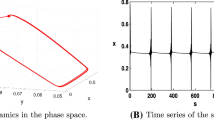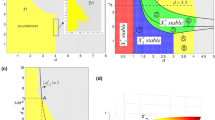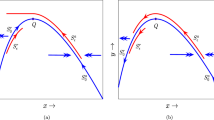Abstract
In this paper, we develop a method of analyzing long transient dynamics in a class of predator–prey models with two species of predators competing explicitly for their common prey, where the prey evolves on a faster timescale than the predators. In a parameter regime near a singular zero-Hopf bifurcation of the coexistence equilibrium state, we assume that the system under study exhibits bistability between a periodic attractor that bifurcates from the singular Hopf point and another attractor, which could be a periodic attractor or a point attractor, such that the invariant manifolds of the coexistence equilibrium point play central roles in organizing the dynamics. To find whether a solution that starts in a vicinity of the coexistence equilibrium approaches the periodic attractor or the other attractor, we reduce the equations to a suitable normal form, and examine the basin boundary near the singular Hopf point. A key component of our study includes an analysis of the long transient dynamics, characterized by their rapid oscillations with a slow variation in amplitude, by applying a moving average technique. We obtain a set of necessary and sufficient conditions on the initial values of a solution near the coexistence equilibrium to determine whether it lies in the basin of attraction of the periodic attractor. As a result of our analysis, we devise a method of identifying early warning signals, significantly in advance, of a future crisis that could lead to extinction of one of the predators. The analysis is applied to the predator–prey model considered in Sadhu (Discrete Contin Dyn Syst B 26:5251–5279, 2021) and we find that our theory is in good agreement with the numerical simulations carried out for this model.











Similar content being viewed by others
Data availability
The manuscript has no associated data.
References
Ashwin P, Wieczorek S, Vitolo R, Cox P (2012) Tipping points in open systems: bifurcation, noise-induced and rate-dependent examples in the climate system. Philos Trans R Soc Ser A 370:1166–1184
Baer SM, Erneux T (1986) Singular Hopf bifurcation to relaxation oscillations. SIAM J Appl Math 46:721–739
Blé G, Loreto-Hernández I (2021) Two-dimensional attracting torus in an intraguild predator model with general functional responses and logistic growth rate for the prey. J Appl Anal Comput 11(3):1557–1576
Braaksma B (1998) Singular Hopf bifurcation in systems with fast and slow variables. J Nonlinear Sci 8(5):457–490
Biggs R, Peterson GD, Rocha JC (2018) The regime shifts database: a framework for analyzing regime shifts in social-ecological systems. Ecol Soc 23(3):9
Boettigera C, Hastings A (2012) Quantifying limits to detection of early warning for critical transitions. J R Soc Interface 7(75):2527–2539
Brøns BM, Krupa M, Wechselberger M (2006) Mixed mode oscillations due to the generalized canard phenomenon. Fields Inst Commun 49:39–63
Carpenter SR, Brock WA (2006) Rising variance: a leading indicator of ecological transition. Ecol Lett 9:311–318
Cantrell SR, Cosner C (2004) Spatial ecology via reaction-diffusion equations. Wiley
Chen A, Sanchez A, Dai L et al (2014) Dynamics of a producer-freeloader ecosystem on the brink of collapse. Nat Commun 5:3713
Clements CF, McCarthy MA, Blanchard JL (2019) Early warning signals of recovery in complex systems. Nat Commun 10:1681
Dakos V, Carpenter SR, van Nes EH, Scheffer M (2015) Resilience indicators: prospects and limitations for early warnings of regime shifts. Philos Trans R Soc Lond B Biol Sci 370:20130263
Deng B (2001) Food chain chaos due to junction-fold point. Chaos 11:514–525
Deng B, Hines G (2002) Food chain chaos due to Shilnikov’s orbit. Chaos 12:533–538
Desroches M, Guckenheimer J, Krauskopf B, Kuehn C, Osinga HM, Wechselberger M (2012) Mixed-mode oscillations with multiple time scales. SIAM Rev 54:211–288
Ermentrout B (2002) Simulating, analyzing, and animating dynamical systems: a guide to XPPAUT for researchers and students. SIAM
Guckenheimer J (2008) Singular Hopf bifurcation in systems with two slow variables. SIAM J Appl Dyn Syst 7:1355–1377
Guckenheimer J, Holmes P (1983) Nonlinear oscillations, dynamical systems and bifurcations of vector fields. Springer, Berlin
Hastings A (2004) Transients: the key to long-term ecological understanding? Trends Ecol Evol 19
Hastings A, Abbott KC, Cuddington K, Francis T, Gellner G, Lai Y-C, Morozov A, Petrovskii S, Scranton K, Zeeman ML (2018) Transient phenomena in ecology. Science 07
Hastings A, Abbott KC, Cuddington K, Francis T, Lai Y-C, Morozov A, Petrovskii S, Zeeman ML (2021) Effects of stochasticity on the length and behaviour of ecological transients. J R Soc Interface 18(180)
Heggerud CM, Wang H, Lewis MA (2020) Transient dynamics of a stoichiometric cyanobacteria model via multiple-scale analysis. SIAM J Appl Math 80(3):1223–1246
Kang Y, Wedekin L (2013) Dynamics of a intraguild predation model with generalist or specialist predator. J Math Biol 67:1227–1259
Krupa M, Szmolyan P (2001) Relaxation oscillations and canard explosion. J Diff Equ 174:312–368
Krupa M, Szmolyan P (2001) Extending geometric singular perturbation theory to nonhyperbolic points—fold and canard points in two dimensions. SIAM J Math Anal 33(2):286–314
Kuske R, Gordillo LF, Greenwood P (2007) Sustained oscillations via coherence resonance in SIR. J Theor Biol 245(3):459–469
Kuznetsov YA (1998) Elements of applied bifurcation theory. Springer
Morozov A, Abbott K, Cuddington K, Francis T, Gellner G, Hastings A, Lai YC, Petrovskii S, Scranton K, Zeeman ML (2020) Long transients in ecology: theory and applications. Phys Life Rev 32:1–40
Muratori S, Rinaldi S (1989) Remarks on competitive coexistence. SIAM J Appl Math 49:1462–1472
Murray JD (2002) Mathematical biology. Springer
Reimer JR, Arroyo-Esquivel J, Jiang J et al (2021) Noise can create or erase long transient dynamics. Theor Ecol 14:685–695
Rinaldi S, Muratori S (1992) Slow-fast limit cycles in predator–prey models. Ecol Model 61:287–308
Rubin J, Earn D, Greenwood P, Parsons TL, Abbott K (2021) Irregular timing of population cycles (2021) hal-03445622v1f
Sadhu S, Chakraborty Thakur S (2017) Uncertainty and predictability in population dynamics of a two-trophic ecological model: mixed-mode oscillations, bistability and sensitivity to parameters. Ecol Complex 32:196–208
Sadhu S (2021) Complex oscillatory patterns near singular Hopf bifurcation in a two time-scale ecosystem. Discrete Contin Dyn Syst B 26:5251–5279
Sadhu S (2022) Analysis of the onset of a regime shift and detecting early warning signs of major population changes in a two-trophic three-species predator–prey model with long-term transients. J Math Biol 85:38
Sanchez A, Gore J (2013) Feedback between population and evolutionary dynamics determines the fate of social microbial populations. PLoS Biol 11(4):e1001547
Scheffer M, Carpenter SR (2003) Catastrophic regime shifts in ecosystems: linking theory to observation. Trends Ecol Evol 18:648–656
Scheffer M (2009) Critical transitions in nature and society, 16. Princeton University Press
Verhulst F (1993) Nonlinear differential equations and dynamical systems. Springer, New York
Zhu J, Kuske R, Erneux T (2015) Tipping points near a delayed saddle node bifurcation with periodic forcing. SIAM J Appl Dyn Syst 14(4):2030–2068
Acknowledgements
The authors thank the anonymous reviewers for their suggestions that led to a significant improvement in the presentation of the article. S.S acknowledges the Provost’s Summer Research Fellowship program in Georgia College for supporting this research and is grateful for having fruitful discussions at the workshops on “Advances in Mathematical Ecology" at the Fields Institute in December 2022 and at the University of Pittsburgh in June 2023.
Author information
Authors and Affiliations
Corresponding author
Additional information
Publisher's Note
Springer Nature remains neutral with regard to jurisdictional claims in published maps and institutional affiliations.
Appendix
Appendix
Expressions for the coefficients in system (6): The expressions for \(\omega \), \(F_{13}\), \(F_{111}\), \(H_3\), \(H_{11}\), and \(\alpha (h)\) in Theorem 3.1 are given below:
Hopf bifurcation of system (3): System (3) undergoes a Hopf bifurcation at \(h=\bar{h}+\zeta A+O(\zeta ^{3/2})\) for sufficiently small \(\zeta >0\), where A is the solution of the equation
Transformation to normal coordinates: The transformations from the original coordinates (x, y, z) to the normal form coordinates (u, v, w) are given below:
where
and
Proof of Lemma 3.1:
Let \(M\ge N\) be the largest integer such that \(\{u(\tau _i)\}_{i=1}^M\) decreases and \(w(\tau )>0\) on \([0, \tau _M]\). By Remark 3.1, the expression for \(\bar{u^2}_{\text {est}}(\tau )\), defined by (15)–(16), holds up to \(O(\delta ^2)\) for all \(\tau \in [\tau _1, \tau _M]\). It is clear from (P2) that \(\bar{w}(\tau )\) also has a decreasing envelope for all \(\tau \in [\tau _1, \tau _N]\). Estimating \(\bar{w}(\tau )\) by \(\bar{w}_{\text {base}}(\tau )\), where \(\bar{w}_{\text {base}}(\tau )\) is defined by (17), it can be easily verified that \(\bar{w}_{\text {base}}(\tau )\) has a unique critical point at \(\tau =\bar{\tau }_m>0\), where
if (18) holds. The critical point corresponds to a minimum of \(\bar{w}_{\text {base}}(\tau )\) with
Since \(\bar{w}(\tau )-\bar{w}_{\text {base}}(\tau )=O(\delta ^2)\) as long as \(w(\tau ) =O(\delta )\), it follows that \(\bar{w}(\tau )\) and the lower envelope of \(w(\tau )\) also attain their minima. Consequently, \(w(\tau )\) attains its global minimum at \(\tau = {\tau }_{\textrm{min}}\), where \({\tau }_{\textrm{min}}= {\bar{\tau }}_m +O(\delta ^2)\). Finally, by (P2), since \(w(\tau )\) has a decreasing envelope on \([\tau _1, \tau _N]\), it is clear that \({\tau }_{\textrm{min}}\ge \tau _N\). \(\square \)
Proof of Lemma 3.2:
We start by considering the relative position of \(w(\tau )\) with respect to \(-\frac{H_{11}}{2H_3} (u^2+v^2)(\tau )\) and show that there exists some \(\tau _c> {\tau }_{\textrm{min}}\) such that \(w(\tau )\) intersects with the upper envelope of \(-\frac{H_{11}}{2H_3} (u^2+v^2)(\tau )\) at \(\tau =\tau _c\). By (P2), \(w(\tau )<-\frac{H_{11}}{2H_3} (u^2+v^2)(\tau )\) for all \(\tau \in [0, \tau _{N}]\). Let \(\{t_k\}_{k=1}^{M}\) and \(\{s_k\}_{k=1}^{M-1}\) be an increasing sequence of locations of relative maxima and minima of \(v(\tau )\) in I respectively with \(t_k<\tau _k<s_k\). Since the trajectory is spiraling inwards, we have that \(\{v(t_k)\}_{k=1}^M\) and \(\{v(s_k)\}_{k=1}^{M-1}\) are decreasing and increasing respectively. Without loss of generality, we assume that \(|v(t_k)|\le |v(s_k)|\) for all \(1\le k \le M-1\). With the aid of (6), we note that the zeros of \(u(\tau )\) correspond to the critical points of \((u^2 +v^2)(\tau )\). Hence the relative maxima and minima of \((u^2 +v^2)(\tau )\) occur at \(s_k\) and \(t_k\) respectively with values \(v^2(s_k)\) and \(v^2(t_k)\) for all k. Denoting the local maxima and minima of \(-\frac{H_{11}}{2H_3} (u^2+v^2)(\tau )\) on the interval \([t_k, s_k]\) by \(M_k\) and \(m_k\) respectively, we then have that \(\{M_k\}_{k=1}^{M-1}\) and \(\{m_k\}_{k=1}^{M-1}\) are both decreasing. If \(u_{\text {env}}(\tau )\) and \(v_{\text {env}}(\tau )\) denote the upper envelopes of \(u(\tau )\) and \(v(\tau )\) respectively, we then have from (9) that up to \(O(\delta ^2)\), \(u_{\text {env}}(\tau )= Ae^{c_2(\tau -\tau _1)}\) and \(v_{\text {env}}(\tau )= Be^{c_2(\tau -\tau _1)}\) for \(\tau \in [\tau _1, \tau _M]\), where A is defined by (20) and
Since \((u^2+v^2)(\tau )\le (u_{\text {env}}^2(\tau ) +v_{\text {env}}^2(\tau ))\) and \(|w(\tau )- \bar{w}_{\text {base}}(\tau )|=O(\delta ^2)\), it suffices to show that there exists some \(\tau _c \in ({\tau }_{\textrm{min}}, \tau _M)\) such that \(\bar{w}_{\text {base}}(\tau )\) intersects with \(\frac{-H_{11}}{2H_3} (u_{\text {env}}^2(\tau ) +v_{\text {env}}^2(\tau ))\) at \(\tau = \tau _c\). To this end, we first note from (17), (19) and (29) that \(\bar{w}_{\text {base}}(\tau )\) intersects with \(\frac{-H_{11}}{2H_3} (u_{\text {env}}^2(\tau ) +v_{\text {env}}^2(\tau ))\) if and only if \(\frac{-H_{11}(A^2+B^2)}{2H_3} > \frac{\delta H_{11}b_1}{2(b_2-\delta H_3)}\), i.e.
Since \(c_2 =O(\alpha \delta /2)\) and \(\vartheta \approx 1\), it then follows that the left hand side of (30) is approximately equal to 2, whereas the right hand side of (30) is less than 1/2 for \(\delta \) sufficiently small, and thus (30) holds. Next, we observe from (13) and (16) that as long as \(\bar{w}_{\text {base}}(\tau )\) is decreasing, \( \bar{w}_{\text {base}}(\tau )\le \frac{-H_{11}}{2H_3} b_1\). Since \(b_1 \approx A^2/2\) and \(c_2<0\), we then have from the definition of \(u_{\text {env}}\) and \(v_{\text {env}}\) that
Hence, for sufficiently small \(\delta >0\),
we must have \(\tau _c > \bar{\tau }_m = \tau _{\text {min}} +O(\delta ^2)\).
Finally, we note that the existence of \(\tau _c\) implies that \(w(\tau )\ge M_i\) on \([s_i, t_{i+1}]\) for some i between 1 and N, and hence the trajectory is in \({\mathbb {R}}^3 {\setminus } \Omega _{\alpha }\) over the interval \([s_i, t_{i+1}]\). The monotonic properties of \(\{M_k\}_{k=1}^{M-1}\) and \(\{m_k\}_{k=1}^{M-1}\), and the fact that \(\bar{w}'(\tau )>0\) for \(\tau >{\tau }_{\textrm{min}}\) will then imply that the trajectory is in \({\mathbb {R}}^3 {\setminus } \Omega _{\alpha }\) over the interval \([s_i, \tau _M]\). Choosing \(\tau _a=s_j\), where \(1<j<M\) is the smallest integer such that \(s_j\le \tau _c\) with \(w(s_j)>M_j\), and \(\tau _b=\tau _M\) then yields the result.
Proof of Lemma 3.3:
Let \(\{\tau _i\}_{i=1}^M\) be an increasing sequence of locations of relative maxima of \(u(\tau )\) such that \(\{u(\tau _i)\}_{i=1}^M\) is decreasing, where M is some integer greater than N to be chosen later. By Remark 3.1, we note that the expressions for \(\bar{u^2}_{\text {est}}(\tau )\) and \(\bar{w}_{\text {base}}(\tau ) \) defined by (15) and (17) respectively, hold up to \(O(\delta ^2)\) for all \(\tau \in [\tau _1, \tau _M]\). If \(\bar{w}(\tau _1)< \frac{\delta H_{11}b_1}{2(b_2-\delta H_3)}\), then it follows from (17) that \(\bar{w}_{\text {base}}(\tau )\) decreases and eventually becomes negative at \(\tau =\tau _e\), where
Since \( |w(\tau ) - \bar{w}_{\text {base}}(\tau )|=O(\delta ^2)\) and \(\bar{w}_{\text {base}}'(\tau )<0\) for all \(\tau \in [0, \tau _M]\), we must have that \(w(\tau )\) also changes its sign near \(\tau _e\). Let \(\tilde{\tau }=\tau _e+o(1)\) be such that \(w(\tilde{\tau })=0\). Choose M large enough such that \(\tilde{\tau } <\tau _{M}\). Since \(q_e\) is unstable along the w-direction and \(w'(\tilde{\tau }) = \frac{\delta }{2} H_{11}u^2 (\tilde{\tau })\le 0\) (follows from (6)), we cannot have \(w(\tau )=0\) for all \(\tau \ge \tilde{\tau }\), thereby leading to \(w(\tau )<0\le -\frac{H_{11}}{2H_3} (u^2+v^2)(\tau )\) for all \(\tau >\tilde{\tau }\). Thus \((u(\tau ), v(\tau ), w(\tau ))\in \Omega _{\alpha }\) for all \(\tau >\tilde{\tau }\). It is also evident from (6) that \(w'(\tau ) < \delta H_3 w\) and therefore if \(w(\bar{\tau })=-\tilde{k}\) for some \(\tilde{k}>0\) and \(\bar{\tau } > \tilde{\tau }\), then by Gronwall’s inequality, \(w(\tau ) < -\tilde{k} e^{\delta H_3 (\tau -\bar{\tau })} \rightarrow -\infty \) as \(\tau \rightarrow \infty \). Consequently, the fast variables \((u(\tau ), v(\tau ))\), governed by system (10), approach (0, 0) as \(\tau \rightarrow \infty \).
Next, we will prove that \(\Omega _{\alpha }\) is positively invariant with respect to \((u(\tau ),v(\tau ),w(\tau ))\) for all \(\tau \ge 0\). Denoting the sequences of local minima and maxima of \(-\frac{H_{11}}{2 H_3}(u^2+v^2)\) by \(\{m_k\}_{k=1}^{M-1}\) and \(\{M_k\}_{k=1}^{M-1}\) and their locations by \(\{t_k\}_{k=1}^{M-1}\) and \(\{s_k\}_{k=1}^{M-1}\) respectively with \(t_k<\tau _k<s_k\), and recalling that \((u(\tau ), v(\tau ), w(\tau )) \in \Omega _{\alpha }\) on \([0, \tau _N]\), we then have that \(w(\tau ) < m_k\) on the interval \([t_k, t_{k+1})\) for all \(1\le k\le N-1\). As in the proof of Lemma 3.2, we have that \(m_k =-\frac{H_{11}}{2H_3}v^2(t_k) =-\frac{H_{11}B^2}{2H_3} e^{b_2 (t_k-\tau _1)}\) up to \(O(\delta ^2)\), where B is defined by (29), and thus we have \(\bar{w}_{\text {base}}(\tau )\approx w(\tau ) <-\frac{H_{11}B^2}{2H_3} e^{b_2 (\tau -\tau _1)}\) on \([0, \tau _{N}]\), i.e.
Since by our assumption \(\bar{w}(\tau _1)< \frac{\delta H_{11}b_1}{2(b_2-\delta H_3)}\), we have from (17) in combination with (31) that \(\bar{w}_{\text {base}}(\tau ) < m_k\) on \([t_k, t_{k+1})\) for all \( 1\le k\le M-1\), i.e. \(\bar{w}_{\text {base}}(\tau )< -\frac{H_{11}}{2 H_3}(u^2+v^2)(\tau )\) for all \(\tau \in [0,\tau _M]\). Finally, since \(w(\tau )=\bar{w}_{\text {base}}(\tau )+O(\delta ^2)\), we can conclude that the solution is in \(\Omega _{\alpha }\) for all \(\tau \in [0,\tau _M]\). Combining this with the fact that \((u(\tau ), v(\tau ), w(\tau ))\in \Omega _{\alpha }\) for all \(\tau >\tilde{\tau }\) proves the lemma. \(\square \)
Rights and permissions
Springer Nature or its licensor (e.g. a society or other partner) holds exclusive rights to this article under a publishing agreement with the author(s) or other rightsholder(s); author self-archiving of the accepted manuscript version of this article is solely governed by the terms of such publishing agreement and applicable law.
About this article
Cite this article
Sadhu, S., Chakraborty Thakur, S. Analysis of long transients and detection of early warning signals of extinction in a class of predator–prey models exhibiting bistable behavior. J. Math. Biol. 88, 70 (2024). https://doi.org/10.1007/s00285-024-02095-8
Received:
Revised:
Accepted:
Published:
DOI: https://doi.org/10.1007/s00285-024-02095-8
Keywords
- Long transients
- Method of averaging
- Zero-Hopf
- Singular Hopf
- Bistability
- Early warning signals
- Slow-fast systems
- Predator–prey models




